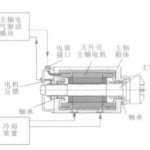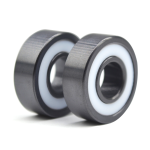Time : Juli 24, 2023
Abstract: High speed machine tools have become one of the main trends in contemporary development, and one of the key components of high-speed machine tools is the high-speed electric spindle. The bearings supporting the electric spindle are subjected to external loads and rotations on the contact points of the ring and rolling element due to the rotation of the spindle, resulting in repeated contact pressure and deformation. The main form of failure of steel bearings is fatigue peeling, with a short anti fatigue life. Ceramic bearings (Si3N4) have advantages such as low density, medium elastic modulus, small thermal expansion coefficient, high hardness, high temperature resistance, corrosion resistance, and no magnetism, which can significantly improve the contact fatigue life of bearings and are more suitable for high-speed applications. This article explores the application of ceramic bearings in high-speed machine tools.
Keywords: high-speed machine tools, steel bearings, ceramic bearings
Preface
High speed machining technology (HSM) is a very important advanced manufacturing technology in contemporary times, which has been increasingly widely applied in mechanical processing industries such as aerospace, automotive manufacturing, and mold industry, and has achieved significant technological and economic benefits. With the development of high-speed machining technology, high-speed and high-precision machine tools have also become one of the main development trends, and one of the key components of high-speed machine tools is the high-speed electric spindle, The bearing supporting the electric spindle is subjected to external load and rotation at the contact point between the ring and the rolling element due to the rotation of the spindle, resulting in repeated contact pressure and deformation. Traditional steel bearings are not suitable for high-speed machine tools due to their own materials and high density, which result in significant centrifugal force during operation and short fatigue life. Ceramic bearings (Si3N4) have the advantages of low density, medium elastic modulus, small coefficient of thermal expansion, high hardness, high temperature resistance, corrosion resistance, and no magnetism, which can significantly improve the contact fatigue life of bearings. Especially, high-speed ceramic bearings can be applied at high speeds of 12000~75000 r/min, suitable for high-speed machine tool spindles and other high-precision equipment.
1.Performance characteristics of high-speed machine tools
1.1 Overview of high-speed machine tools
High speed machine tools are generally CNC and precision machine tools, which shorten the cutting and non cutting time during processing. For complex shapes, difficult to machine materials, and high hardness materials, the machining process is reduced to maximize the accuracy and quality of products, improve labor productivity, and achieve economy. High speed machine tools should have the following conditions.
1.2 Advantages of high-speed machine tools
The superiority of high-speed machine tools is reflected in high-speed machining technology, which mainly manifests in an increase in material removal rate of 3-6 times (high production efficiency); Cutting force is 30%~50% lower (for machining low stiffness parts and difficult to machine materials); More than 95% of the cutting heat is carried away by the chips, and the workpiece remains at room temperature with low thermal deformation (high machining accuracy); The forced vibration frequency is far away from the Natural frequency of the machine tool (good surface quality); During high-speed cutting, the deformation of the material is completed in an instant, and the surface residual stress is small (the fatigue strength of the part is high).
1.3 Performance characteristics and key components of high-speed machine tools
The biggest characteristic of the transmission structure of high-speed machine tools is zero transmission, that is, zero transmission of the spindle system (electric spindle) and zero transmission of the feed system (linear motor). Direct Drive has no transmission chain, low transmission error, low noise, high accuracy, low inertia, and sensitive response. It can quickly start and stop, shorten the transition process of movement, and has a simple structure, making it easy to achieve functional component modularization and professional and serial production.

Figure 1 System composition of high-speed electric spindle unit
The key components of high-speed machine tools include high-speed electric spindle (as shown in Figure 1), high-speed feed system, and machine tool high stiffness support system. The high-speed feed system includes high-speed ball screw, linear motor, and parallel virtual axis mechanism.
Machine tool bearings refer to bearings for general machine tool spindles, feed systems, transmission systems, various high-speed and high-power electric spindle bearings, grinding machine head bearings, as well as bearings required for various CNC machine tools, machining centers, and automatic machining lines. This type of bearing requires high accuracy, with accuracy levels of P2, P4, and P5. This type of bearing has high technological content, high added value, stable performance, and long service life. Conventional steel bearings cannot fully meet the requirements of high-speed and high-precision machine tools, while ceramic ball bearings can effectively compensate for this defect.
Ceramic ball bearings are developed for high-speed, heavy load, low temperature and no lubrication conditions in harsh environments in the Arms industry. They are a perfect combination of new materials, new processes and new structures.
2.1 Main characteristics of ceramic bearings
The performance to price ratio of ceramic bearings is much better than that of all steel bearings, with a lifespan that can be increased by more than three times. In addition, it also has the following characteristics:
2.2 Main categories of ceramic bearings
Ceramic bearings can be divided into high-speed bearings, high-temperature bearings, corrosion-resistant bearings, anti magnetic bearings, electrically insulated bearings, and vacuum bearings according to their usage; According to technical level, it can be divided into deep groove ball bearings, self-aligning ball bearings, single row angular contact ball bearings, and one-way thrust ball bearings; According to the material, it can be divided into zirconia all ceramic bearings, silicon nitride all ceramic bearings, fully loaded ball all ceramic bearings, ceramic cage all ceramic bearings, and hybrid ceramic ball bearings (as shown in Table 1).
From the above table, it can be seen that the ceramic bearing suitable for high-speed and high-precision spindle applications is silicon nitride all ceramic bearing, which is made of silicon nitride material.
Table 1 Main Categories and Applications of Ceramic Bearings
| according to the materials | Category
|
Performance application | field |
| Zirconia all ceramic bearings
|
It has the characteristics of anti magnetic and electrical insulation, wear and corrosion resistance, oil-free self-lubrication, high temperature resistance, and high cold resistance
|
Suitable for extremely harsh environments and special working conditions | |
| Silicon nitride all ceramic bearings
|
Featuring high rotational speed, strong load capacity, and resistance to high environmental temperatures
|
Suitable for high-speed, high-precision, and rigid spindle applications | |
| Fully loaded ball all ceramic bearings
|
Featuring high load capacity, corrosion resistance, and temperature resistance
|
Suitable for medium to low speeds, attention should be paid to installing the notch surface at the end that does not bear axial load during installation | |
| Ceramic cage all ceramic bearings
|
Featuring wear resistance, high strength, corrosion resistance, and self-lubrication
|
Suitable for harsh environments such as extreme corrosion, ultra-high and low temperatures, and high vacuum | |
| Hybrid ceramic ball bearing
|
It has the characteristics of low density, high hardness, low friction coefficient, wear resistance, self-lubrication, and good rigidity | Suitable for high-speed, high-precision, and long-life environments |
2.3 Technical performance of silicon nitride (Si3N4)
Silicon nitride material is not the hardest and toughest in industrial ceramics, but in bearing applications that require high performance, silicon nitride is considered to have the best comprehensive mechanical and physical properties. The comprehensive rolling contact peeling test and bearing test of silicon nitride both prove that silicon nitride material has good compactness and homogeneity, thus possessing good rolling contact fatigue resistance. Compared with steel bearings, silicon nitride bearings have unique advantages.
2.4 Centrifugal force of the ball during high-speed operation
During the high-speed rotation process of the bearing ball, centrifugal force will be generated. If the centrifugal force is large, the dynamic load will be large, easy to slip, and the bearing life will be low. The magnitude of centrifugal force is calculated according to the following formula:
![]()
In the equation: ρ Is the density of the rolling ball material, kg/m3; D is the diameter of the rolling ball, m; Dm is the pitch diameter of the ball bearing, m; ω Is the common angular velocity of the ball, rad/s.
From the formula, it can be seen that the application of reducing the centrifugal force of the ball is to use compact small diameter balls and use lightweight materials as balls, such as bearings made of silicon nitride (Si3N4) material, which reduces the centrifugal force by about 60% compared to steel bearings.
2.5 Heating and Lubrication Technology of Ceramic Ball Bearings
During high-speed rotation, bearings generate heat due to friction with the main shaft. Therefore, it is necessary to lubricate the bearings. The bearing lubrication technology mainly includes grease lubrication, oil mist lubrication, oil air lubrication, and spray lubrication, among which oil air lubrication is the most widely used. Figure 2 shows the oil air lubrication system of rolling bearings.
3 Conclusion
Due to its excellent performance characteristics, ceramics can significantly improve the contact fatigue life of bearings, greatly expanding the application field of rolling bearings. At present, ceramic ball bearings have entered the stage of mass production, especially in the fields of high-speed precision spindle bearings for machine tools and high-temperature and corrosion-resistant bearings, which have broad application prospects. Vigorously developing the national machine tool industry and improving the accuracy of machine tool products, ceramic bearings will play a crucial role, and the adoption of new nano composite ceramic materials is a trend to improve the accuracy and performance of ceramic bearing products.
More about XZBRG Vollkeramik-Schrägkugellager:
Vollkeramik-Kugellager, die vollständig aus Keramikmaterial bestehen. Innere/äußere Laufringe und Kugeln bestehen entweder aus Siliziumnitrid (Si3N4), Zirkoniumoxid (ZrO2) oder Siliziumkarbid (SiC). Sie sind vollrollig (ohne Käfig) oder mit einem Käfig aus PEEK oder PTFE erhältlich. Vollkeramiklager sind für Anwendungen mit mittlerer Belastung und mittlerer Geschwindigkeit. Es ist nicht möglich, die Rundheit des Innen- und Außenrings zu erreichen, die bei Präzisionsstahllagern zu finden ist, daher haben Vollkeramiklager niedrigere Drehzahlwerte.
